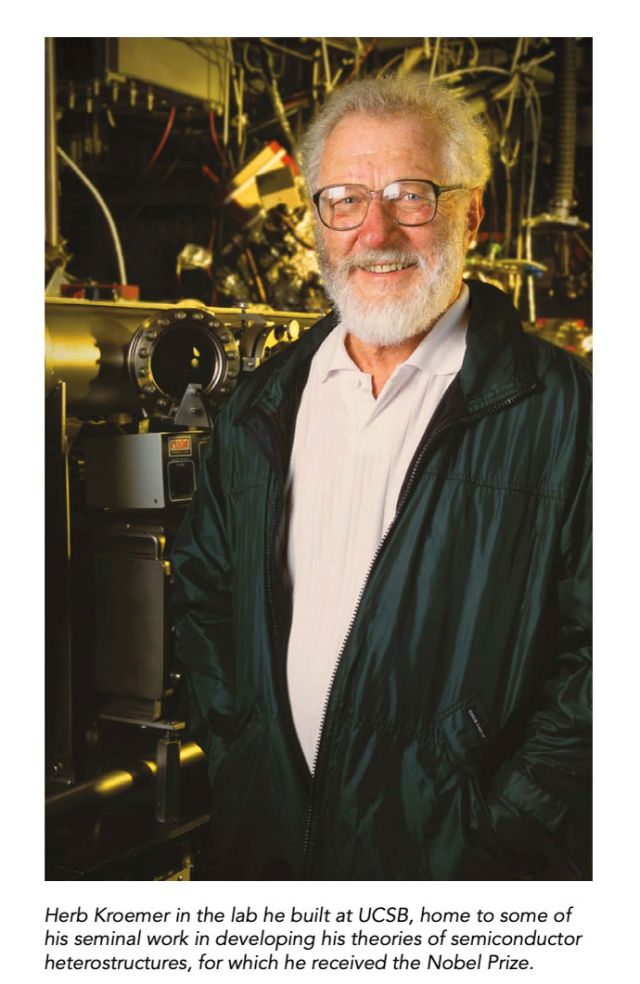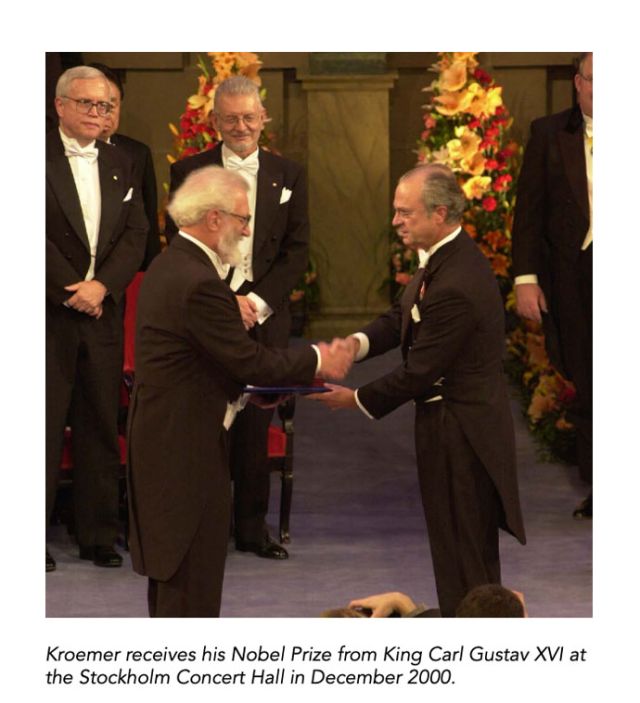
In Memoriam: Herbert Kroemer, ECE Distinguished Prof. & Nobel Laureate (Physics 2000)
From the COE/CLS Convergence magazine (Summer 2024) article – "Herb Kroemer (1928-2024)" (pg. 30)
Herb Kroemer's heterostructures changed the world – the ECE professor and laureate left a world-changing, multi-layered legacy
UC Santa Barbara and the world lost one of the greatest technological visionaries of our time on March 8, when emeritus professor Herb Kroemer, who earned a Nobel Prize for his seminal work on compound semiconductors, died at the age of 95. Born August 25, 1928, in Weimar, Germany, Kroemer came to UCSB in 1976, where he held the Donald W. Whittier Chair in Electrical Engineering and joint faculty appointments in the Electrical and Computer Engineering Department (ECE) and the Materials Department. Kroemer received the Nobel Prize in Physics in 2000 in recognition of his work, which included developing semiconductor heterostructures that are used in high-speed- and opto-electronics and laid the foundation for the modern era of microchips, computers, and information technology.
“In India, there is the concept of a guru, someone who is a teacher in the broadest sense, someone who teaches not only curriculum, facts, skills, and information, but also morals, ethics, leadership, graciousness, and generosity,” said Umesh Mishra, dean of the UCSB College of Engineering, who was born and raised in India. “We have been fortunate to share time with Herb Kroemer, who embodies that broad ethos of the guru, who taught physics, materials science, and electrical engineering at the highest level, but also life and behavior. There are not many gurus, and we have lost one.”

Following work in several research laboratories in Germany and the United States, in 1976 Kroemer persuaded the Electrical & Computer Engineering Department at UCSB to direct a substantial portion of its limited resources to expanding the department’s small semiconductor research program, with a particular focus on the emerging field of compound semiconductor technology. Seeing an opportunity for UCSB to become a leading institution in that area, Kroemer himself became the first member of what would soon become one of the world’s preeminent groups dedicated to the physics and technology of compound semiconductors and the many devices they enable. His discoveries provided the basis for numerous technological innovations we now use on a daily basis – from cell phone and satellite communications to high-speed transistors and solid-state lighting.
“Herb was an inspiration to everyone,” said ECE and Materials professor John Bowers, a world expert on integrated lasers, the Fred Kavli Chair in Nanotechnology, and the director of the UCSB Institute for Energy Efficiency. (See P. 12) “He invented the double-heterostructure laser, which earned him a Nobel Prize, but also enabled the first commercial semiconductor lasers, which are used worldwide in fiber-optic networks and enabled the internet, transforming the world.”
In addition to the Nobel Prize, Kroemer received the Grand Cross of the Order of Merit of the Federal Republic of Germany, the highest award given by the German government. He was a member of both the National Academy of Engineering and the National Academy of Sciences, and a fellow of the American Physical Society and the Institute of Electrical and Electronics Engineers.
COE/CLS Convergence magazine (Summer 2024) - "Herb Kroemer (1928-2024)" (pg. 30)
See What Some Other UCSB Faculty Members Had To Say Upon Kroemer’s Passing